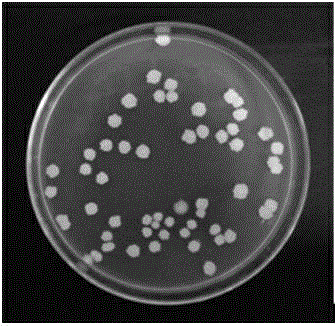Salt-resistance Bacillusmethylotrophicus strain LJ and application thereof
A methylotrophic and bacillus technology, applied in the field of microorganisms, can solve the problems of low viable bacteria, inability to grow, poor persistence and stability, etc. Effect
- Summary
- Abstract
- Description
- Claims
- Application Information
AI Technical Summary
Problems solved by technology
Method used
Image
Examples
Embodiment 1
[0019] 1. Isolation and screening of salt-tolerant strains
[0020] On July 4, 2012, 24 soil samples were collected from the rhizosphere soil of Tobacco Plants in Binzhou, Shandong, and 1g of each soil sample was suspended in 100ml sterile water and diluted to 10 5 times. Use Gibbons improved medium or beef extract peptone medium for screening, Gibbons improved medium formula: casein hydrolyzate 5.0g, sodium citrate 3.0g, yeast extract powder 10.0g, KCl2.0g, peptone, 5.0g, MgSO 4 ·7H 2 O, 20g NaCl 100g, pH7.0. Use 1%, 4%, 7%, 10% NaCl to screen the salt-tolerant strains step by step. Use a pipette to take 0.1ml of the soil dilution solution and spread it on the two medium plates, incubate at 30°C for 2 to 3 days, select colonies that grow well at 10% salt concentration, and store them for future use after repeated streaking and purification. to a salt-tolerant strain LJ.
[0021] 2. Identification of the salt-tolerant strain LJ
[0022] The screened strain LJ was culture...
PUM
 Login to View More
Login to View More Abstract
Description
Claims
Application Information
 Login to View More
Login to View More - R&D
- Intellectual Property
- Life Sciences
- Materials
- Tech Scout
- Unparalleled Data Quality
- Higher Quality Content
- 60% Fewer Hallucinations
Browse by: Latest US Patents, China's latest patents, Technical Efficacy Thesaurus, Application Domain, Technology Topic, Popular Technical Reports.
© 2025 PatSnap. All rights reserved.Legal|Privacy policy|Modern Slavery Act Transparency Statement|Sitemap|About US| Contact US: help@patsnap.com



